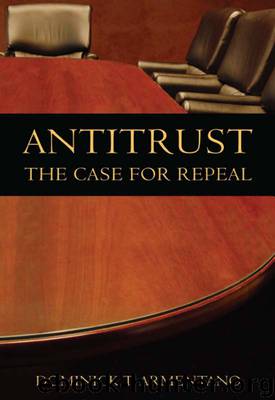Antitrust by Dominick T. Armentano

Author:Dominick T. Armentano [Dominick T. Armentano]
Language: eng
Format: epub
ISBN: 978-0-94546-625-3
Publisher: Ludwig von Mises Institute
Published: 2007-11-06T16:00:00+00:00
The Ready-to-Eat Cereals Case
The infamous Federal Trade Commission case against the leading ready-to-eat (RTE) cereal companies is an excellent example of the antitrust confusion over product differentiation, consumer preferences, and barriers to entry.
In 1972, the FTC brought suit against Kellogg, General Foods, General Mills, and Quaker Oats, arguing that the firms’ 90-percent market share constituted monopolization in the RTE cereals industry.5 The leading companies competed by proliferating new brands of cereal and variations of old brands; they rarely engaged in direct price competition. According to the FTC, the market-share position of the firms was a direct function of this “wasteful” brand proliferation, which had the effect of severely restricting new-firm entry and competition. The costs and risks associated with developing, producing, and marketing a new cereal brand were generally prohibitive for new companies. In addition, the lack of price competition allowed the leading companies to earn excessive profits over a long period of time. The solution, according to the FTC, was to break up the leading companies and force them to license their popular trademark brand names to would-be rivals.
The FTC was no doubt correct in concluding that the high risk of failure in producing new cereal brands limited market entry. It was also true that certain economies associated with size, especially in advertising, tended to restrict the number of new competitors. But it is not true that any of this was regrettable from any consumer perspective, or that the competitive process was endangered, or that these restrictions could justify any remedial antitrust activity.
Efficiency in the use of resources, including efficiency in the specific types of products produced, can always restrict the number of competitors. As has been argued, the very purpose of the competitive market process is to discover which products consumers prefer, for whatever reason, and then to produce and sell those products to consumers. The fact that leading firms with long experience and economies of scale may be able to accomplish this task more efficiently than smaller or newer organizations is irrelevant from a consumer perspective: consumer welfare is not injured thereby and resources are not misallocated.
The issues can be put another way. If cereal brand proliferation had been unsuccessful from a consumer view-point, the larger companies would have lost market share to other companies and would no longer have been the leading firms in the industry. If cereal costs for the larger companies had been higher—not lower—than their would-be competitors, the larger firms could have lost market share to smaller, more efficient companies and, again, would not have remained leading firms. In short, if the larger RTE firms had not been efficient and successful with their products, they could not have remained the leaders in their industry for decades.
The fact that the leading companies had introduced dozens of new cereal brands successfully in an uncertain market setting was direct evidence of sustained efficiency in the use of resources, not evidence of monopoly power that misallocated economic resources. Consumers were not coerced into purchasing new cereal brands; they were invited to try them.
Download
This site does not store any files on its server. We only index and link to content provided by other sites. Please contact the content providers to delete copyright contents if any and email us, we'll remove relevant links or contents immediately.
The Social Psychology of Inequality by Unknown(2918)
The Plant Paradox by Dr. Steven R. Gundry M.D(2525)
The Writing on the Wall by Anselm Jappe(1991)
Working for Yourself by J.D. (Nolo) Stephen Fishman(1781)
Every Landlord's Legal Guide by Janet Portman & Stewart Marcia & Ralph Warner(1610)
The First 20 Hours: How to Learn Anything ... Fast by Kaufman Josh(1593)
ADHD on Trial by Michael Gordon(1512)
Decisive by Chip Heath(1497)
Working for Yourself by Stephen Fishman J.D. (Nolo)(1458)
Drafting Contracts: How and Why Lawyers Do What They Do, Second Edition by Stark Tina L(1444)
A Practical Guide to International Arbitration in London by Hilary Heilbron(1376)
The Economist Aug 8th 2015 by The Economist(1369)
Restitution by Restitution(1368)
The Lord of the Rings: The Fellowship of the Ring, the Two Towers, the Return of the King by J. R. R. Tolkien(1363)
Intellectual Property Strategy by John Palfrey(1358)
The Economist Aug 29th 2015 by The Economist(1325)
Get What's Yours for Medicare by Philip Moeller(1281)
Collusion by Luke Harding(1268)
Persuasion by Owner(1252)
